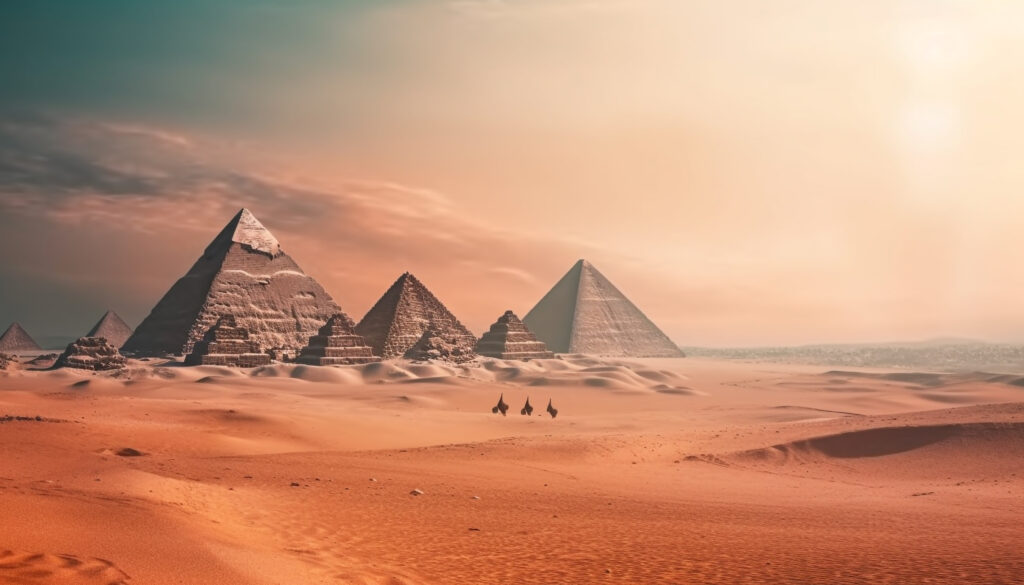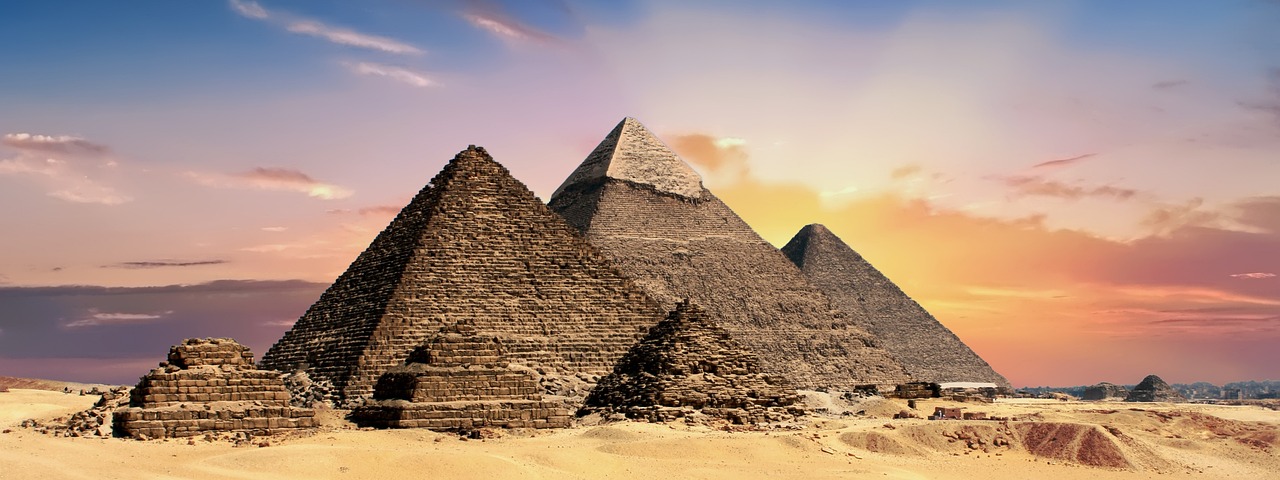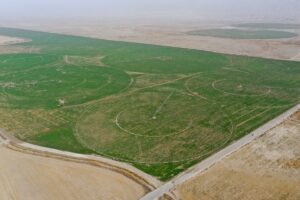In the vast desert sands of ancient Egypt, under the watchful grace of the gods, a monumental task was unfolding—a task so ambitious it would stand as an eternal testament to ingenuity and determination. They were constructing the pyramids: structures of such magnitude and mystery they would puzzle the minds of people for millennia.
 Pin
Pin Image by: freepik.com
Table of Contents
Monuments of Eternity: Constructing the Great Egyptian Pyramids of Giza
It is believed it all started with the pharaoh’s command—a divine declaration to erect a tomb that would carry his soul through the afterlife. The Nile River, a serpentine strip of nourishment slicing through the land, would play a crucial part in fulfilling the pharaoh’s decree, providing sustenance and transport.
Every year, when the Nile flooded, it rendered the fields unusable for farming, and this season, known as Akhet, became a time when the population could be mobilized for colossal state projects. They gathered—that mass of humanity, tens of thousands strong, from skilled architects to laborers driven by faith and service to their ruler. They traveled from near and far, gathering like the flocks of ibis at the river’s edge, converging on the chosen site.
First came the meticulous planning, led by the royal vizier, chief of works. They located a perfect site—on the Giza plateau, on the west bank of the Nile, where the sun sets, symbolizing the realm of the dead. As architects and astronomers aligned the pyramid’s base to the cardinal points with uncanny precision, the labor began.
Transporting the massive limestone blocks required a mixture of sheer human strength and ingenuity. Workers harnessed the power of the river, placing stones on boats and ferrying them from far-off quarries. Upon arrival, the stones were unloaded, and an intricate system of sledges and ropes, lubricated by water to ease their passage, moved the stones across the desert sands.
The ramp theories are many, but one possibility is a spiraling external ramp that rose alongside the growing structure, allowing stones to be hauled to higher levels. Workers would fit each block with careful precision, tapping into an intrinsic understanding of geometry and masonry.
Above them, the scorching sun charted its path across the heavens. Below them, the firmament of workers toiled, turning chaos of raw stone and desert into a testament of order and design.
As decades passed and generations labored, the pyramid rose—a series of steps first, which were later filled in to give that smooth, triangular geometry that has come to be synonymous with the word ‘pyramid’. The final touch was the Tura limestone casing, gleaming white to reflect the sun’s blaze, crowning their work with light that could be seen from miles away.
When the capstone was finally placed, a culmination of this aspirational symphony of human exertion, it was not merely a pharaoh’s tomb that stood against the backdrop of the eternal sky. It was a legacy of perseverance, proof that from the dust of the earth and with the might of collective spirit, humanity could reach for the stars.
As the sun set on the completed Giza plateau, with the mighty Sphinx guarding the horizon, each stone in the three great pyramids held within it a story—a story of sweat, blood, ambition, and mortal yearning for the divine. The pyramids, majestic and silent, had much to tell… if only they could speak.
Eternal Monuments to Divine Rulers: The Legacy of Egypt's Giza Pyramids and Their Royal Tombs
The Pyramids of Giza were constructed as the final resting places for Egypt’s pharaohs, specifically for the Fourth Dynasty kings Khufu, Khafre, and Menkaure. These monumental structures served as grand tombs to safeguard the pharaohs’ journey into the afterlife.
 Pin
Pin Khufu, also known by the Hellenized name Cheops, was the second pharaoh of the Fourth Dynasty. He is credited with building the Great Pyramid, also known as the Pyramid of Khufu, which is the largest of the three pyramids and one of the Seven Wonders of the Ancient World. This awe-inspiring monument was likely the result of his prosperous reign and remained the tallest man-made structure for over 3,800 years. The pyramid contains three main chambers: the King’s Chamber, the Queen’s Chamber, and a subterranean chamber.
Khafre (or Chephren), Khufu’s son, was the builder of the second pyramid at Giza. His pyramid stands slightly smaller than his father’s, with the inclusion of complex mortuary temple architecture and the Great Sphinx nearby. This structure, which bears his likeness, has spawned countless theories and mysteries about the purpose and construction of the Sphinx.
Menkaure’s pyramid is the smallest of the three and marks the end of the major pyramid-building era. His pyramid complex also included three smaller pyramids for his queens and an elaborate mortuary temple.
The pyramids were constructed with precision and align with the stars, particularly the Orion Belt, which was associated with the god Osiris. Their positioning and construction methods were impressive feats, intended to reflect the pharaohs’ divine nature and power, guaranteeing their immortality and status in the afterlife.
The pyramids were filled with all the goods a king might need in the afterlife, including gold vessels, furniture, and food. The walls of the burial chambers were often inscribed with texts intended to protect the pharaoh’s soul and aid him in the afterlife, known as Pyramid Texts.
The choice to build such grand structures for burial purposes demonstrates how seriously the ancient Egyptians took the concept of the afterlife and their reverence for their rulers. By creating these timeless monuments, the builders of the Pyramids of Giza ensured that the memory of their pharaohs would endure through the ages, as they indeed have.
Reaching for the Heavens: The Multifaceted Legacy of the Giza Pyramids
 Pin
Pin The Pyramids of Giza, the quintessential symbols of ancient Egypt, have long captivated the imagination of onlookers both old and new. They are architectural marvels, steeped in mystery and dense with historical significance.
At the core of their purpose, these pyramids represent an evolution of tomb and mortuary culture in Ancient Egypt. During the Old Kingdom (c. 2686–2181 BCE), Pharaohs were considered demi-gods, their rule ordained by divine right. As such, their earthly deaths were treated with great ceremony, and they were provided with tombs grand enough to mark their passage into the afterlife. The Egyptians believed in an afterlife where the dead Pharaoh would continue to guide and protect the people. Thus, the pyramids functioned as monumental burial places designed to honor and house these “gods” for eternity.
The largest and oldest of the three, the Great Pyramid, was built for Pharaoh Khufu (Cheops). It stands as a testament to this ruler’s power and the resources he commanded, including a large workforce and copious materials. The surrounding pyramids for Khafre and Menkaure follow this pattern of divine celebration and reverence.
The Giza Pyramids were aligned with incredible precision to the stars. The Great Pyramid is particularly noted for its astronomical alignments; its sides are closely aligned with the four cardinal points of the compass, an impressive feat which has led to various theories about its construction. This celestial alignment underscores the strong connection the ancient Egyptians placed between their gods, their kings, and the cosmos.
Their shape, ascending skywards, symbolizes the rays of the sun, and the pharaoh’s ascension to the heavens, linking the rulers with Ra, the sun god. The smooth, angled sides of the pyramids are thought to symbolize the rays of the sun, used by the soul of the king to ascend to the heavens and join the gods, particularly the sun god Ra.
The pyramids also represent the pinnacle of ancient Egyptian architectural, mathematical, and astronomical knowledge. Their precise measurements, the technique used for cutting and transporting the stone, and the exactness of their layout demonstrate an advanced understanding of engineering and geometry. The ability to organize and sustain such a large workforce for the decades-long process of building also shows the administrative prowess of the civilization.
The Sphinx, another monumental structure part of the Giza Plateau, represents the face of a pharaoh with the body of a lion, which many believe is a symbol of royal power and protection that guards the tombs.
On another level, the Giza Pyramids represent the apex of Egypt’s power and the civilization’s unwavering commitment to an intricate belief system centered on the afterlife. They are emblems of a sophisticated culture that produced profound advancements in various fields of knowledge.
The Pyramids of Giza were multifaceted symbols, conflating royal power, religious devotion, astronomical observation, and technical prowess into their massive stone structures, making them timeless legacies of human civilization’s endless ingenuity.
Video: Deciphering the Labyrinth — Inside the Great Pyramid of Giza's Hidden Chambers and Ancient Mysteries
The Pyramids of Giza have captivated humanity for millennia, and the largest, known as the Great Pyramid of Khufu, holds particular intrigue. What’s inside is a network of chambers, passageways, and mysteries.
Inside the Great Pyramid
At the heart of the Great Pyramid lies the King’s Chamber, the main burial room. Constructed of red granite, you’d find here a now-empty sarcophagus. The room is reached through the Grand Gallery, a 47-meter-long corridor with a corbelled roof, an impressive example of ancient engineering. Intriguingly, the King’s Chamber is connected to the outside world by the so-called “air shafts,” although their true purpose remains disputed—spiritual, symbolic, or architectural are prevailing theories.
Below the King’s Chamber lies the Queen’s Chamber, which, despite its name, was likely never intended for a queen’s burial. This limestone-lined chamber has niche and two further “air shafts” of mysterious function. In the 1990s, a robotic explorer discovered these shafts to be blocked by doors with metal handles—an enigma suggesting more secrets.
At ground level, an unfinished subterranean chamber is hewn into the bedrock. This may have been the original burial chamber, but it remains incomplete, and why it was abandoned is unknown.
The Great Pyramid’s construction also implies a network of service corridors and galleries, designed to provide access during construction rather than for any mortuary function. The so-called Relieving Chambers above the King’s Chamber, discovered by Colonel Howard Vyse in 1837, display graffiti believed to have been left by the workers.
Adjacent to the Great Pyramid are two smaller, yet still impressive, pyramids, one for Pharaoh Khafre and one for Menkaure. Khafre’s Pyramid is similar in its internal arrangement, with a single, high chamber accessed by a passage from the north face of the pyramid. Menkaure’s Pyramid is more complex, with three chambers: one subterranean chamber, and two above ground level.
Surrounding the pyramids are mastaba tombs for officials and family, as well as the Great Sphinx and the Solar Barque Museum housing a disassembled boat intended to ferry the pharaoh across the heavens.
The precision and scale of the internal structures within the Giza pyramids demonstrate the advanced understanding of architecture and construction by the ancient Egyptians. While much knowledge has been gained, more remains unknown, protected by the silence of the ancient stones.
Visiting the Pyramids of Giza
Visiting the Pyramids of Giza, the timeless monuments that have captured human imagination for millennia, can be an extraordinary experience. While the outer allure is undeniable, many visitors also wish to explore the inner world of these ancient structures.
Going Inside the Pyramids: Yes, you can go inside some of the Pyramids of Giza. The three main pyramids are known as the Great Pyramid, built for Pharaoh Khufu (Cheops), the Pyramid of Khafre, and the Pyramid of Menkaure. The Great Pyramid and the Pyramid of Khafre typically have passageways open to the public.
The entrance ticket to the Giza Plateau may include access to the site but not the interiors of the pyramids. Separate tickets to enter the Great Pyramid and the Pyramid of Khafre, if it is open, must be purchased in addition to the general admission ticket. The Pyramid of Menkaure may also occasionally be accessible, but this can vary.
Inside, the narrow passages lead to the central chambers where the sarcophagi were placed. These passages are not elaborate: they’re small, often steep, and can be claustrophobic. There are no hieroglyphic decorations inside the large pyramids, a stark contrast to the elaborately decorated tombs in the Valley of the Kings in Luxor.
Climbing the Pyramids: Climbing the pyramids is illegal, and for good reasons. Firstly, the act of climbing can cause damage to the ancient stones, contributing to the erosion and degradation of these irreplaceable historical monuments. Secondly, climbing is dangerous. The stones can be loose and falls have occurred, sometimes fatal.
There was a time when tourists were allowed to climb certain pyramids, but laws have tightened to protect both the individuals and the structures. Despite this, occasional incidences of people illegally scaling the structures make the news, often resulting in fines or legal action against the climbers.
For anyone curious about the pyramid’s exterior up-close, the grounds surrounding the pyramids offer ample opportunity to touch the stones, marvel at the construction, and contemplate the ancient workmanship. The experience of being within the proximity of these ancient wonders provides a profound sense of history.
Visitors can still enjoy the incredible experience of entering the internal passages of the Pyramids of Giza. Due respect and adherence to the preservation rules will ensure that the wonder of these ancient structures can be kept intact for future generations to experience and enjoy.
What is the other name by which Egyptian kings are known?
The rulers of ancient Egypt are commonly known as pharaohs. This term originated from the Egyptian word ‘per-aa’, which means “Great House,” referring originally to the palace of the king and its grandeur, rather than the king himself. Over centuries, ‘pharaoh’ became the official designation for the monarch of ancient Egypt.
Pharaohs were considered not just kings but also gods on earth. They were seen as mediators between the gods and the people, and their duty was to uphold ma’at, or cosmic order, harmony, and justice. The concept of the pharaoh has an enduring legacy in Egyptian civilization, symbolizing power, religious significance, and the centralization of authority.
Throughout Egypt’s dynastic period, which spanned over three millennia, the title “pharaoh” was adopted by rulers along with a series of five names upon accession to the throne: the Horus name, Nebty name, Golden Horus name, the prenomen, or throne name, and the nomen, or birth name. These names were hieroglyphically written within cartouches—oval with a horizontal line at one end signifying that the text enclosed is a royal name.
The extensive line of Egyptian pharaohs presents a chronological tapestry of dynastic rule shaping Egypt’s culture, religious practices, economy, and architecture. The construction of monumental structures, such as the pyramids and the vast temples that dot the Nile’s banks, stand testament to the pharaohs’ absolute rule and the highly organized bureaucratic system they presided over. The most prominent of these are the Pyramids of Giza, built as grand tombs for the pharaohs and guarded by the enigmatic Sphinx.
Pharaohs’ roles merged over time with the figure of Osiris, god of the afterlife, and during their own posthumous worship, they were believed to interact with the pantheon of gods, becoming one with Osiris in death. This divine aspect of the pharaoh’s role solidified their status as both religious and political leaders.
In essence, pharaohs were the axis of ancient Egyptian civilization, embodying the earthly and divine realms’ union and wielding unparalleled power over the land famed for the Nile and its monuments. Their reigns, recorded in hieroglyphs and chronicled by later historians, have left an enduring legacy of what royal absolute power looked like in the ancient world.
FAQs: The Construction of the Egyptian Pyramids
The Egyptian pyramids were constructed by the ancient Egyptians, primarily during the Old and Middle Kingdom periods. Skilled laborers, architects, and workers, some of whom may have been conscripted during the Nile River’s flood season, built these monumental structures.
The primary purpose of the Egyptian pyramids was to serve as tombs for the pharaohs and their consorts. They were part of a larger complex that included temples and other structures meant for the performance of funerary rituals and to ensure the continuity of the king’s afterlife.
The exact methods of pyramid construction are still debated, but the process likely involved quarrying large limestone blocks, transporting them using sledges and boats, and assembling them using ramps, levers, and manpower.
The pyramidal shape is thought to have religious significance, symbolizing the primordial mound from which ancient Egyptians believed the earth was created. The sloping sides were also intended to help the pharaoh’s soul ascend to heaven and join the gods.
The time it took to build a pyramid varied greatly depending on its size. For example, the Great Pyramid of Giza is estimated to have taken around 20 years to complete.
This is a common misconception. There is substantial archaeological evidence suggesting that the workforce was not composed of slaves but rather paid laborers, who took pride in their work and were well-cared for.
The pyramids are precisely aligned with the cardinal points of the compass. This alignment, combined with their location on the west bank of the Nile, which is where the sun sets, was significant for the Egyptians’ beliefs about the afterlife. The west was associated with the realm of the dead.
Yes, archaeologists and researchers continue to study the pyramids, using new technologies such as 3D modeling and ground-penetrating radar to uncover more details about their construction, purpose, and the civilization that built them.


































